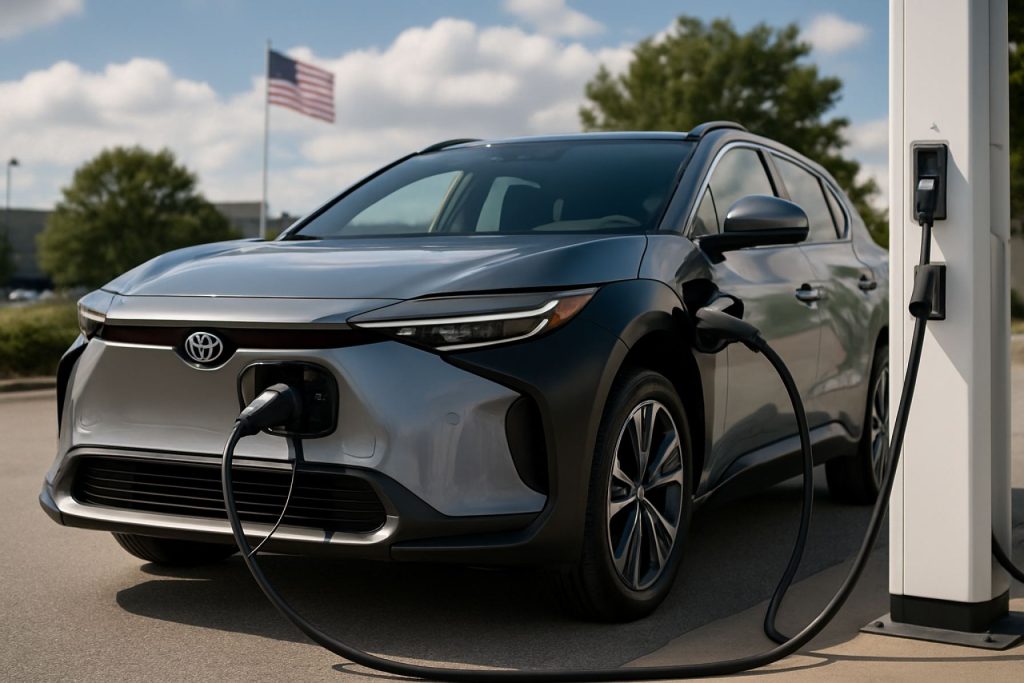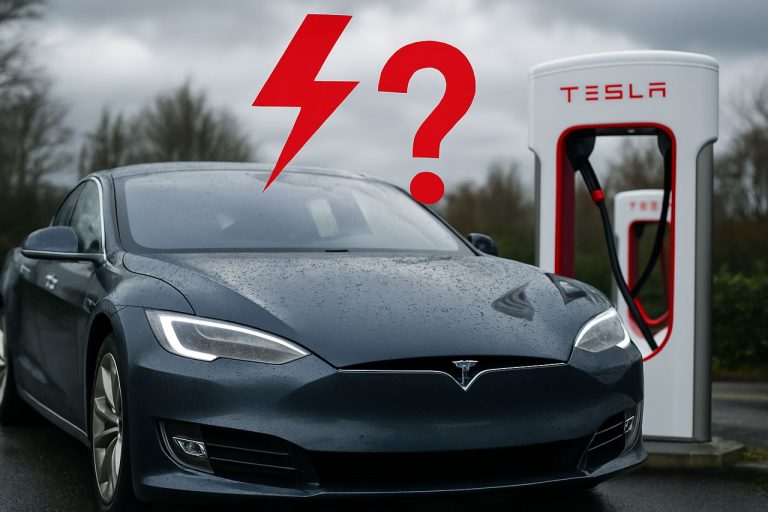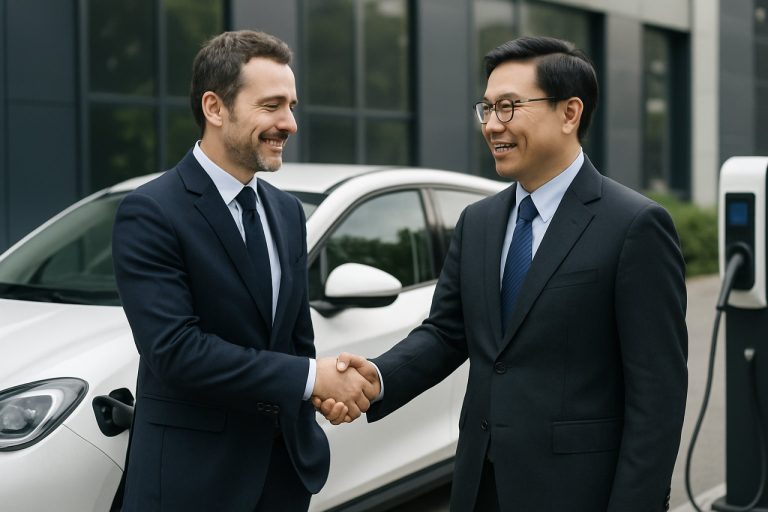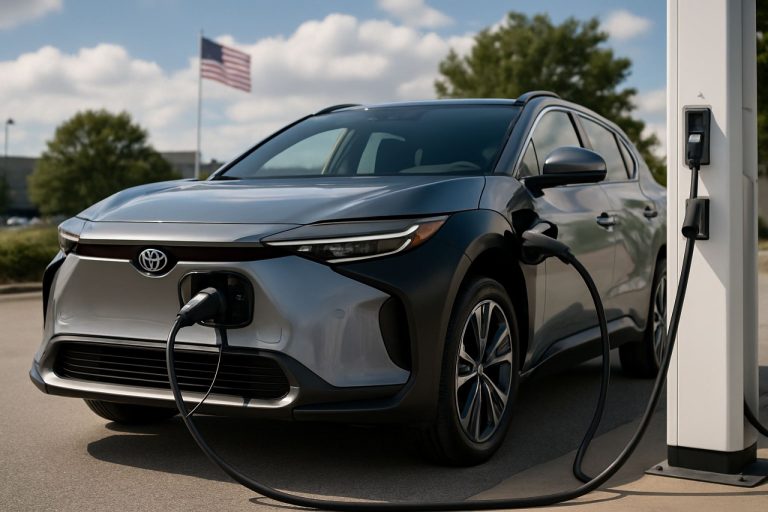
- Toyota is accelerating its electric vehicle (EV) strategy, expanding its U.S. lineup to five distinct electric models, including the redesigned “bZ” and adventure-focused “bZ Woodland.”
- The American EV market is poised for growth, with expectations that up to 30% of new vehicle sales could be electric within a few years, up from today’s 8% share.
- For the first time, Toyota will manufacture EVs in the United States, strengthening its commitment to local innovation and production.
- Toyota continues a “multi-pathway” strategy, combining hybrid expertise with new EV technology to address diverse consumer needs and market uncertainties.
- The automaker aims to challenge Tesla’s dominance by promising improved range and charging speed, reflecting ambition to set new standards in the U.S. EV market.
Clouds drifted across the Texas sky as Toyota unveiled its latest vision—a portfolio of electric vehicles charging directly into the heart of the American auto market. The stage was set for a decisive pivot: after years of hybrid dominance and cautious electric experimentation, the world’s largest automaker has thrown its weight behind an electric future.
The American EV market stands at a crossroads. Growth has slowed, with Tesla, once the industry’s standard-bearer, facing declining sales and dwindling momentum. Yet industry leaders like Toyota see the horizon broadening, not shrinking. Their analysts project a dramatic rise in demand—for every household with three cars, one could easily go electric. If households owning two cars convert even half of a single garage space to electric, nearly 30% of new vehicle sales could soon be EVs—a figure more than triple today’s 8% market share.
Against this backdrop, Toyota flexes its muscle. The current lineup in the U.S. includes the robust “bZ4X” SUV and another electric sibling. But the company is not stopping there. Later this year, Toyota will not only overhaul the bZ4X—renaming and refining it into simply “bZ”—but also introduce the adventure-ready “bZ Woodland” and the compact, nimble “C-HR” SUV. Luxury buyers will soon see two upgraded electric models from Lexus, lifting Toyota’s EV roster to five distinct models tailored for American roads and tastes.
The drive doesn’t stop at imports. For the first time, Toyota plans to produce EVs on American soil next year, deepening its roots in a market hungry for both innovation and reliability. Toyota will continue to leverage its global expertise in hybrids—vehicles that have proven to be an ingenious bridge in the shift to clean energy. All these efforts form part of a sweeping “multi-pathway” strategy: Toyota’s answer to an uncertain, rapidly evolving energy landscape.
Still, the competition blazes on. Tesla—despite controversies and turbulence around its high-profile CEO—retains a formidable grip, commanding over 40% of the U.S. EV market. Yet, Toyota’s U.S. executives promise that their new EVs will leapfrog the status quo in range and charging speed, narrowing the gap and, perhaps, even setting a new standard for the road ahead.
Key takeaway: Toyota is no longer content to watch the electric revolution unfold from the sidelines. By expanding its EV lineup, investing in U.S. manufacturing, and doubling down on consumer-centric innovation, the automaker signals its intent to lead, not follow, in America’s electric vehicle era. The next few years will reveal if the company’s quiet confidence is just the spark the American market needs.
Curious about Toyota’s full spectrum of innovation and commitment to sustainability? Explore their journey at Toyota.
Toyota’s Bold EV Bet: Can America’s Hybrid King Steal Tesla’s Electric Crown?
Toyota’s electrification push goes far beyond the teasers and headlines. As the American EV market faces both skepticism and untapped opportunity, the Japanese giant’s playbook is packed with features, strategies, and tech that could truly shake up the industry. Here’s what you need to know, what the source didn’t tell you, and how it matters for drivers and the future of mobility.
Market Landscape: Why Toyota’s Timing Could Be Ideal
– Rising Consumer Confidence in EVs: Recent consumer surveys (like the J.D. Power E-Vision Intelligence Report) suggest that over 50% of U.S. households are considering an electric vehicle for their next purchase—despite current growth slowdowns.
– Federal & State Incentives: Legislation such as the Inflation Reduction Act offers up to $7,500 in federal tax credits for qualifying EVs manufactured in North America, a crucial incentive for Toyota’s US-built models.
– Range Anxiety Is Shrinking: The median EV range surpassed 250 miles in 2023 (DOE Alternative Fuels Data Center), up from 125 miles just five years ago—one of Toyota’s primary targets for improvement.
– Charging Infrastructures Expanding: With recent investments from both government and private sectors (see the U.S. Department of Energy’s EV charging networks), public chargers are becoming more accessible, addressing a key barrier to adoption.
Features, Specs & Pricing: What To Expect
Toyota’s upcoming electric vehicles (EVs) promise significant leaps, but let’s break down the most likely improvements based on industry leaks, patent filings, and analyst projections:
– New “bZ” Lineup: The redesigned bZ SUV is expected to offer over 300 miles of range per charge (Surpassing current bZ4X’s 252 EPA-rated miles).
– Quick-Charge Capability: Toyota is rumored to target 80% battery charge in just 20-30 minutes, fending off complaints about slow charging vs. Tesla.
– All-Wheel Drive Options: Both the “bZ Woodland” and “C-HR” SUV will likely be available with AWD, a popular feature for SUVs in the American market.
– Safety Innovations: Expect standard Toyota Safety Sense systems, with advanced lane-assist, adaptive cruise, and possibly hands-off driving updates in select models (CRN.com).
– Pricing: Analysts expect the new bZ models to start near $40,000 before incentives, aligning them closely with Tesla’s Model Y and Ford Mustang Mach-E.
How-To: Preparing for Toyota EV Ownership
1. Assess Charging Needs: If considering an EV, audit your home’s electrical system and research local charging infrastructure.
2. Explore Incentives Early: Visit official sources like IRS.gov or Toyota to check eligibility for tax credits and rebates in your state.
3. Test Drive Multiple Brands: As Toyota, Tesla, and Ford all expand their lineups, comparing real-world driving (especially range and comfort) can be enlightening.
4. Plan for Software Updates: Expect over-the-air (OTA) updates for vehicle software—a growing industry standard across all new Toyota EVs.
Real-World Use Cases & Life Hacks
– Road Trips: With improved range and nationwide charging networks, Toyota’s new SUVs will accommodate longer journeys, making EVs finally practical for family vacations.
– Urban Living: The coming compact EVs (like the “C-HR” SUV) are designed for city dwellers with tight parking and shorter commutes, offering flexible charging options.
– Fleet Upgrades: Businesses transitioning to electric delivery or service vehicles will likely find Toyota’s reputation for reliability and low maintenance a key selling point.
Security & Sustainability
– Battery Recycling: Toyota has announced plans to develop battery recycling programs in the U.S., addressing concerns about rare earth metals and end-of-life disposal.
– Cybersecurity: With proprietary software and connected car platforms, Toyota has invested in end-to-end security, although no system is invulnerable—consumers should stay vigilant for recall bulletins and update notifications.
Industry Trends, Reviews & Comparisons
– Multi-Pathway Approach: Unlike Tesla’s pure-EV focus, Toyota will continue to innovate in hybrids, plug-in hybrids, and hydrogen fuel-cell vehicles, offering more options for consumers wary of “range anxiety.”
– Consumer Reviews: Early reviews of the bZ4X praised its comfort and safety tech but criticized its range and charging network. Toyota aims to address both with the upcoming bZ overhaul.
– Comparisons: While Tesla offers seamless Supercharger integration, Toyota’s EVs will leverage the now-standardized CCS charging format, compatible with expanding third-party networks (Electrek).
Controversies & Limitations
– Late to the Party: Critics argue that Toyota’s delayed entry into full EVs has cost it valuable market share and brand cachet (Reuters).
– Batteries Sourcing: Like its competitors, Toyota faces scrutiny for the environmental and ethical impacts of mining for battery components.
Pressing Reader Questions, Answered
1. Will Toyota’s U.S.-manufactured EVs qualify for tax credits?
Yes, as long as they meet all U.S. Treasury and IRS content requirements.
2. How will Toyota ensure enough charging support for its EVs?
Toyota is partnering with charging network providers and exploring joint ventures with other automakers to ensure nationwide compatibility.
3. What about long-term reliability?
Toyota EVs will inherit warranty coverage similar to its hybrids—often extending battery and powertrain coverage up to 8 years/100,000 miles.
4. Are Toyota EVs compatible with Tesla’s Supercharger network?
Starting in 2025, Toyota EVs in North America will use the North American Charging Standard (NACS), allowing access to Tesla’s network (source: Toyota press release).
Insights & Predictions
– U.S. Market Share: If Toyota delivers on its promises for range, price, and U.S. manufacturing, it could claim 10-15% of the U.S. EV market by 2027, challenging both Tesla and legacy American automakers.
– Resale Value: Toyota’s reputation for durability bodes well for future EV residuals—an area where some early EVs (Nissan Leaf, Chevy Bolt) have struggled.
Actionable Recommendations & Quick Tips
– Stay Updated: Bookmark Toyota’s official site (Toyota) and sign up for launch alerts if you’re interested in pre-orders.
– Plan Charging Solutions: Install a Level 2 home charger to maximize convenience and take advantage of low overnight electricity rates.
– Take Advantage of Hybrids: For now, hybrids and plug-in hybrids are excellent bridges to full electrification—consider them if charging infrastructure near you is limited.
– Test Your Route: Apps like PlugShare and ChargePoint allow you to map out EV charging stops ahead of time for every make—not just Tesla.
Conclusion
Toyota’s EV offensive is more than just good PR: it’s a real play for the American market and your driveway. For buyers, this means more choices tailored to every lifestyle, improved tech, and greater buyer leverage. Keep an eye out—the electric revolution is about to get more competitive, convenient, and (for once) truly consumer-focused.
Explore, compare, and get ready for the future of driving with confidence [Toyota](https://toyota.com)



